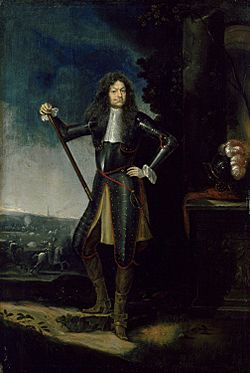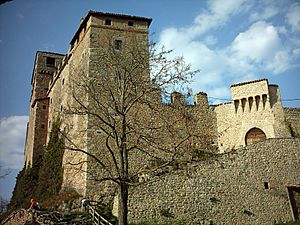Raimondo Montecuccoli facts for kids
Quick facts for kids
Raimondo Montecuccoli
|
|
|---|---|

Raimondo Montecuccoli, Duke of Melfi by
|
|
| Born | 21 February 1609 Pavullo nel Frignano, Duchy of Modena and Reggio |
| Died | 16 October 1680 (aged 71) Linz, Archduchy of Austria |
| Buried | |
| Allegiance | |
| Service/ |
Imperial Army |
| Years of service | 1628–1678 |
| Rank | Generalfeldmarschall |
| Battles/wars | Thirty Years' War
First War of Castro |
| Awards | Order of the Golden Fleece |
Raimondo Montecuccoli (born February 21, 1609 – died October 16, 1680) was a very important soldier from Italy. He worked for the Habsburg Monarchy, a powerful family that ruled many lands. He was also a Prince in the Holy Roman Empire and the Duke of Melfi.
Many people thought Montecuccoli was as good a general as the famous French general Turenne. Both generals helped create new ways of fighting, especially with soldiers lined up in rows.
Early Life and Military Start
Raimondo Montecuccoli was born on February 21, 1609. His birthplace was the Castello di Montecuccolo in Pavullo nel Frignano, a town near Modena in Italy.
Joining the Army
When he was just sixteen, Montecuccoli started his army career. He joined as a private soldier under his uncle, Count Ernesto Montecuccoli. His uncle was a well-known Austrian general.
After four years of fighting in Germany and the Low Countries, Raimondo became an infantry captain. He was badly hurt twice in 1631. First, when soldiers attacked Neubrandenburg, and again at the first Battle of Breitenfeld. During the second battle, he was captured by the Swedes.
Rising Through the Ranks
In 1632, he was wounded again at the Battle of Lützen. After he got better, he became a major in his uncle's army. Soon after, he was promoted to lieutenant-colonel of cavalry.
He fought well at the first Battle of Nördlingen in 1634. The next year, he became a colonel by bravely leading his heavy cavalry through a breach (a gap in a wall) at Kaiserslautern.
He continued fighting in places like Pomerania, Bohemia, and Saxony. He took part in battles like Wittstock and Chemnitz. In 1639, he was captured again at Melnik. He was held prisoner for two and a half years in Szczecin and Weimar.
Learning in Captivity
During his time as a prisoner, Montecuccoli used the time wisely. He studied military science, which is about how to fight wars. He also learned about geometry from Euclid, history from Tacitus, and Vitruvius' architecture. All this time, he was planning his own important book about war.
Becoming a Commander
After being released, Montecuccoli returned to Italy in 1642. He led soldiers who were loyal to the Duke of Modena during the First War of Castro. This war ended without a clear winner.
In 1643, he was promoted to lieutenant-field-marshal. He also got a seat on the Council of War, which helped plan military actions. From 1645 to 1646, he fought in many different areas. He fought against Prince Rákóczy of Transylvania in Hungary. He also fought against the French near the Danube and Neckar rivers. Later, he fought against the Swedes in Silesia and Bohemia.
His victory at Triebel in Silesia earned him the rank of General of Cavalry. At the battle of Zusmarshausen in 1648, his strong rearguard fighting saved the Imperial army from being completely defeated.
After the Thirty Years' War
After the Peace of Westphalia in 1648, which ended the Thirty Years' War, Montecuccoli mostly worked for the Council of War. He also traveled as a representative for the emperor to places like Flanders and England. He even went to Sweden as an envoy for the pope to Queen Christina. He also won a big tourney in Modena.
Wars in the North and East
In 1657, Montecuccoli married Countess Margarethe de Dietrichstein. Soon after, the Emperor ordered him to join a mission. This mission was to fight against Prince Rákóczy, Charles X Gustav of Sweden, and the Cossacks. These groups had attacked Poland in a war known as The Deluge or the Second Northern War.
During this conflict, Montecuccoli was promoted to lead a division of soldiers. He became a field-marshal in the Imperial army. His division, along with other armies, fought in Denmark against the Swedes. The war ended with the Peace of Oliva in 1660. Montecuccoli then returned to serve his ruler.
Defending Against the Ottoman Empire
From 1661 to 1664, Montecuccoli had fewer soldiers but still managed to defend Austria against the Turks. At St. Gotthard Abbey, he and Carl I. Ferdinand Count of Montenari defeated the Turks very thoroughly. This led to a twenty-year truce (a break in fighting).
For his success, he received the Order of the Golden Fleece. He also became the president of the Council of War and the director of artillery. He spent a lot of time writing his books about military history and science.
Fighting Louis XIV
Montecuccoli was against the growing power of the French army under King Louis XIV. When war broke out, he was given command of the Imperial forces. In 1673, he skillfully outsmarted his rival, Turenne, on the Neckar and Rhine rivers. He captured Bonn and joined his army with William III, the prince of Orange.
He briefly left the army in 1674. But Turenne's successes brought him back to command. For months, these two famous commanders moved their armies around the Rhine valley. Just before a big battle, Turenne was killed. Montecuccoli then quickly invaded Alsace. There, he faced another great general, the Great Condé. The siege of Philippsburg was Montecuccoli's last military achievement.
Later Life and Legacy
The rest of Montecuccoli's life was spent working in military administration. He also continued his writing and scientific studies in Vienna. In 1679, the emperor made him a prince of the empire. Soon after, the King of Spain gave him the title of Duke of Melfi.
Montecuccoli died in an accident in Linz in October 1680.
His Impact
As a general, Montecuccoli was considered one of the best soldiers of his time, alongside Turenne and Condé. He was celebrated for stopping the Turkish advance, earning him the title "savior of Europe."
He was also an important military thinker. One of his most famous quotes is: "For war you need three things: 1. Money. 2. Money. 3. Money." His book, Memorie della guerra (Memories of War), greatly influenced how wars were fought after his time. Montecuccoli was a master of 17th-century warfare. He was excellent at building and attacking forts, moving armies, and cutting off enemy supplies. He also believed in having permanent armies, which was a new idea for the future of warfare.
Family
In 1657, Montecuccoli married Countess Margarethe de Dietrichstein. His only son, Leopold Philip Montecuccoli, died in 1698. This meant the title of prince ended. However, the title of count continued through his daughters in two family lines: Austrian and Modenese.
Memorials
In 1934, the Italian navy launched a ship named in his honor. It was called the Raimondo Montecuccoli. This light cruiser served in the Regia Marina (Italian Royal Navy) during World War II.
See also
 In Spanish: Raimondo Montecuccoli para niños
In Spanish: Raimondo Montecuccoli para niños



